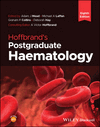General consultative haematology
John Willan
Frimley Health NHS Foundation Trust, UK
Oxford University Hospitals NHS Foundation Trust, UK
Search for more papers by this authorJohn Willan
Frimley Health NHS Foundation Trust, UK
Oxford University Hospitals NHS Foundation Trust, UK
Search for more papers by this authorAdam J Mead PhD, FRCP, FRCPath, FMedSci
Haematopoietic Stem Cell Biology Laboratory, Medical Research Council Molecular Haematology Unit, Medical Research Council Weatherall Institute of Molecular Medicine, University of Oxford, Oxford, UK
Search for more papers by this authorMichael A Laffan DM, MRCP, FRCPath
Department of Immunology and Inflammation, Faculty of Medicine, Imperial College London, London, UK
Search for more papers by this authorGraham P Collins DPhil, FRCP, FRCPath
Department of Haematology, Oxford Cancer and Haematology Centre, Oxford, UK
Search for more papers by this authorDeborah Hay DPhil, MRCP, FRCPath
Nuffield Division of Clinical Laboratory Sciences, Radcliffe Department of Medicine, University of Oxford, Oxford, UK
Search for more papers by this authorA Victor Hoffbrand MA, DM, FRCP, FRCPath, FRCP (Edin), DSc, FMedSci
Emeritus Professor of Haematology Honorary Consultant Haematologist
University College London, London, UK
Royal Free Hospital, London, UK
Search for more papers by this authorSummary
An extraordinary range of non-haematological pathologies can disturb the full blood count of a patient, and lead to a referral for specialist review by a haematologist. In order to ensure timely and appropriate management of the patient, whilst reducing the risk of over-investigation, it is important to understand these links, to enable possible differential diagnoses to be correctly considered.
In this chapter we consider how different pathologies can impact haematological indices. We consider in turn cancers, diseases of kidney or liver, connective tissue diseases, congestive cardiac failure, endocrine disorders, changes to body mass index, environmental, nutritional and age-related changes, and finally infections. We will explore the myriad ways in which these underlying disorders can manifest with abnormalities of the blood count.
Selected bibliography
- Astor B , Muntner P , Levin A et al. ( 2002 ) Association of kidney function with anaemia: the Third National Health and Nutrition Examination Survey (1988–1994) . Archives of Internal Medicine 162 ( 12 ): 1401 – 8 .
- Bohlius J , Bohlke R , Djulbegovic B et al. ( 2019 ) Management of cancer-associated anemia with erythropoiesis-stimulating agents: ASCO/ASH clinical practice guideline update . Blood Advances 3 ( 8 ): 1197 – 1210 .
- Fletcher A , Forbes A , Svenson N et al. ( 2022 ) Guideline for the laboratory diagnosis of iron deficiency in adults (excluding pregnancy) and children . British Journal of Haematology 196 ( 3 ): 523 – 529 .
- Harding B , Whitney B , Nance R et al. ( 2020 ) Antiretroviral drug class and anaemia risk in the current treatment era among people living with HIV in the USA: a clinical cohort study . BMJ Open 10 ( 3 ): e031487 .
- Mikhail A , Brown C , Williams J et al. ( 2017 ) Renal association clinical practice guideline on anaemia of chronic kidney disease . BMC Neprology 18 : 345 .
- Otieno S , Altahan A , Karri S , et al. ( 2021 ) CIN or not: an approach to the evaluation and management of chronic idiopathic neutrophilia . Blood Review 46 : 100739 .
- Terpos E , Ntanasis-Stathopoulos I , Elalamy I et al. ( 2020 ) Hematological findings and complications of COVID-19 . Americal Journal of Haematology 95 ( 7 ): 834 – 847 .



